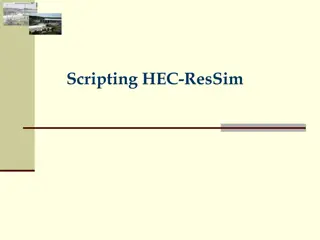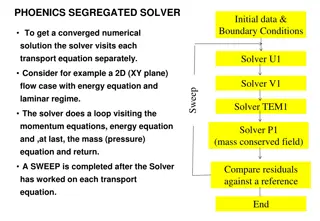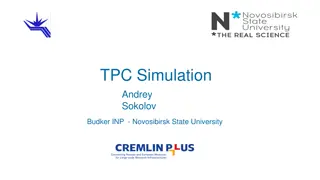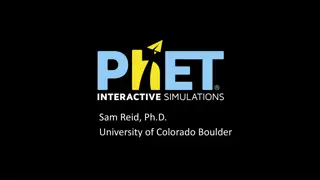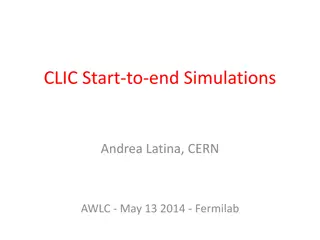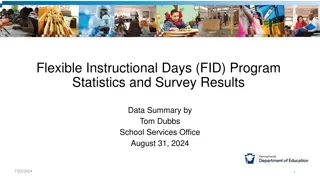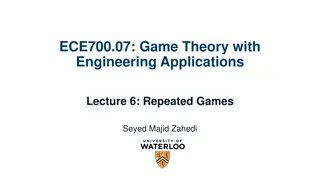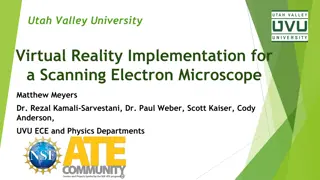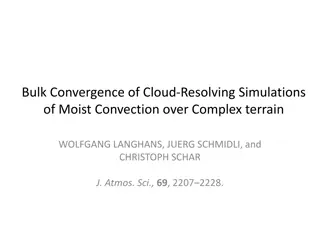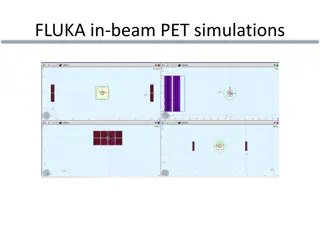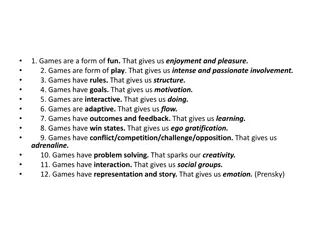Understanding the Effectiveness of Instructional Games and Simulations
This research delves into the use of Analysis of Patterns in Time (APT) to measure interactions in instructional games, comparing it with Linear Models Approach (LMA). Findings show that students are more engaged during interactive instruction. The significance lies in APT measuring relations while LMA relates measures, emphasizing the importance of observing temporal patterns directly. The limitations of traditional methods like Pearson correlations and multiple regression are highlighted, showcasing the unique insights offered by APT.
Uploaded on Oct 08, 2024 | 0 Views
Download Presentation

Please find below an Image/Link to download the presentation.
The content on the website is provided AS IS for your information and personal use only. It may not be sold, licensed, or shared on other websites without obtaining consent from the author. Download presentation by click this link. If you encounter any issues during the download, it is possible that the publisher has removed the file from their server.
E N D
Presentation Transcript
MEASURING EFFECTIVENESS OF INSTRUCTIONAL GAMES AND SIMULATIONS RODNEY D. MYERS, PH.D. INDEPENDENT SCHOLAR THEODORE W. FRICK, PH.D. PROFESSOR EMERITUS, INDIANA UNIVERSITY 1
INTRODUCTION Using Analysis of Patterns in Time (APT) to measure and analyze interactions with a serious game. Overview of APT Comparison with traditional methods Examples and explanations Quantitative Research Study The Diffusion Simulation Game and diffusion of innovations theory Using APT for summative assessment of a group s data Concluding Remarks 2
COMPARE THESE FINDINGS Analysis of Patterns in Time (APT): Students in elementary schools are about 13 times more likely to be off-task during non-interactive classroom instruction, when compared with their engagement during interactive instruction. Linear Models Approach (LMA): The amount of interactive classroom instruction predicts 32 % of the variance in student task engagement, leaving 68 % of the variance unexplained. These results are based on the same classroom observation data (see Frick,1990). 3
WHATS THE DIFFERENCE? The short answer: APT measures the relation. LMA relates the measures. Why is this important? When we make separate measures of phenomena we have only independent measures to associate. We can do only traditional analysis of associations, such as Pearson correlations, multiple regression, ANOVA, etc. 4
WHATS THE DIFFERENCE? In APT, temporal patterns are observed and coded. APT queries directly count patterns in temporal maps. There is no way to derive these pattern counts from separate measures of phenomena, as done in the Linear Models Approach (LMA). 5
WHATS THE DIFFERENCE (CONT D) The mathematical conclusion is that there is no way to uniquely determine the joint probability distribution given only the marginal probability distributions... (Frick, 1984, p. 79) The LMA is handicapped, as was Humpty Dumpty after falling from the wall: We cannot reconstruct the relations of those pieces to each after Humpty Dumpty fell (we cannot put Humpty Dumpty together again ) We are limited to counting the separate pieces on the ground, not their relations to each other. We refer to this problem as aggregation aggravation. Maybe we should instead call it the Humpty Dumpty Effect. 6
EXAMPLE OF APT TEMPORAL MAP FOR THE DIFFUSION SIMULATION GAME If we have a good Internet connection: https://www.indiana.edu/~simed/aptmulti map/aptdsgSummary.php Show a couple of maps. Do a couple of queries. 19
THE DIFFUSION SIMULATION GAME & DOI THEORY Research Study: Using APT for Serious Games Analytics 2-Year Calendar Innovation- Decision Phases Activities Staff Members & Personal Info 20
USING APT TO ANALYZE GAMEPLAY DATA Generalizations from DOI theory DSG activities Adopter types Decision phases Example: Local Mass Media & Print Innovators & Early Adopters Awareness & Interest Mass media should be effective in spreading knowledge about an innovation, especially among innovators and early adopters 9 strategies: scoring algorithm for patterns of joint occurrences 21
USING APT TO ANALYZE GAMEPLAY DATA Population 1,280 players, 2,679 games 28 players finished 10 or more games Randomly selected 15 players for group analysis (240 games, 11,913 turns) 22
GAME OUTCOMES Game Outcome Maximally Successful Highly Successful Moderately Successful Unsuccessful Adoption Points 220 166 219 146 165 0 - 145 Games (n=240) 12 71 81 76 23
GAME OUTCOMES Player 5 3 2 1 0 1 2 3 4 5 6 7 8 9 10 11 12 24
GAME OUTCOMES Player 10 3 2 1 0 1 2 3 4 5 6 7 8 9 10 11 25
GAME OUTCOMES Player 9 3 2 1 0 1 2 3 4 5 6 7 8 9 10 11 12 13 14 15 16 17 18 19 26
EXAMPLE QUERY Query Result WHILE the FIRST Joint Temporal Event is true (Phrase 1): Turn is in state starting or continuing, value <= 15 Target Earlier Adopter is in state starting or continuing, value = True Average conditional probability is 0.12112 and SD is 0.04778 Total frequency of JTEs = 2312 out of 19304 Overall proportion of JTEs = 0.11977 27
GROUP RESULTS Strategy 1: Target earlier adopters and opinion leaders early in the game to work toward critical mass. Earlier Adopters Opinion Leaders 0.12112 0.07598 0.01641 4.63 0.09245 0.05569 0.01195 4.66 All High Low Ratio 28
GROUP RESULTS Strategy 2: Use Personal Information and Talk To activities to establish empathy and rapport in order to understand a client s needs, sociocultural values and beliefs, and previous exposure to related ideas. Talk To 0.42881 0.07762 0.19132 0.41 High Rank 0.17012 All High Low Ratio 29
GROUP RESULTS Strategy 6: Use the Site Visit activity to allow the visitors to see the innovation in use, providing how-to knowledge and reducing uncertainty about the consequences of adoption. Site Visit 0.04615 0.00487 0.02043 High Rank 0.05822 All High Low Ratio 0.24 30
GROUP RESULTS Strategy 9: Use the Training Workshop (Self) and Materials Workshop activities to provide knowledge and assistance regarding procedures and principles to further reduce uncertainty and increase confidence. Training 0.02479 0.01513 0.00324 4.67 Materials High Rank 0.02924 0.01810 0.00393 4.61 0.31558 All High Low Ratio 31
USING APT FOR FORMATIVE ASSESSMENT DURING GAMEPLAY Summative Used by instructor and/or learner Evidence of understanding and application Analyze prior gameplay maps Identify persistent misconceptions Formative Dynamic analysis of gameplay Provide scaffolds (e.g., hints, coaching) Requested by learner Before turn: hint After turn: explanation or prompt for reflection 32
USING APT FOR FORMATIVE ASSESSMENT DURING GAMEPLAY Player 3 Un Hi Md Hi Mx Hi Overall 0.02 0.07 0.10 0.10 0.05 0.09 Poor use of mass media High 0.02 0.02 0.03 0.03 0.03 0.03 Low 0.00 0.05 0.05 0.08 0.03 0.06 Generalization 5-13: Mass mediachannels are relatively more important at the knowledge stage, and interpersonal channels are relatively more important at the persuasion stage in the innovation-decision process (p. 205). Generalization 7-22: Earlier adopters have greater exposure to mass media communication channels than do later adopters (p. 291). 33
CONCLUDING REMARKS Using Pattern Matching to Assess Gameplay (Chapter 19) Loh, C. S., Sheng, Y., & Ifenthaler, D. (Eds.). (2015). Serious game analytics: Methodologies for performance measurement, assessment, and improvement. New York, NY: Springer. Contact us: Rod Myers rod@webgrok.com Ted Frick frick@indiana.edu 34



